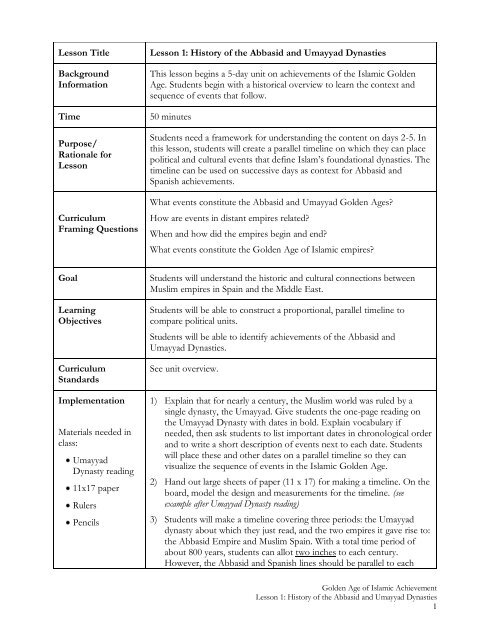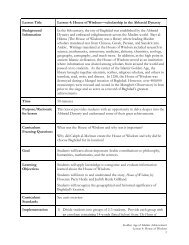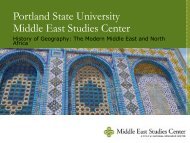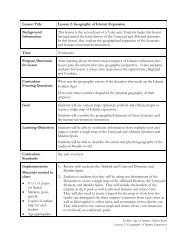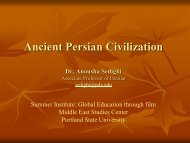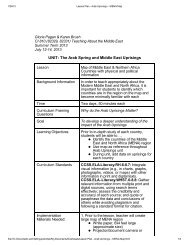Lesson Title Lesson 1: History of the Abbasid and Umayyad ...
Lesson Title Lesson 1: History of the Abbasid and Umayyad ...
Lesson Title Lesson 1: History of the Abbasid and Umayyad ...
- No tags were found...
You also want an ePaper? Increase the reach of your titles
YUMPU automatically turns print PDFs into web optimized ePapers that Google loves.
<strong>Lesson</strong> <strong>Title</strong>BackgroundInformationTimePurpose/Rationale for<strong>Lesson</strong>CurriculumFraming Questions<strong>Lesson</strong> 1: <strong>History</strong> <strong>of</strong> <strong>the</strong> <strong>Abbasid</strong> <strong>and</strong> <strong>Umayyad</strong> DynastiesThis lesson begins a 5-day unit on achievements <strong>of</strong> <strong>the</strong> Islamic GoldenAge. Students begin with a historical overview to learn <strong>the</strong> context <strong>and</strong>sequence <strong>of</strong> events that follow.50 minutesStudents need a framework for underst<strong>and</strong>ing <strong>the</strong> content on days 2-5. Inthis lesson, students will create a parallel timeline on which <strong>the</strong>y can placepolitical <strong>and</strong> cultural events that define Islam’s foundational dynasties. Thetimeline can be used on successive days as context for <strong>Abbasid</strong> <strong>and</strong>Spanish achievements.What events constitute <strong>the</strong> <strong>Abbasid</strong> <strong>and</strong> <strong>Umayyad</strong> Golden Ages?How are events in distant empires related?When <strong>and</strong> how did <strong>the</strong> empires begin <strong>and</strong> end?What events constitute <strong>the</strong> Golden Age <strong>of</strong> Islamic empires?GoalLearningObjectivesCurriculumSt<strong>and</strong>ardsImplementationMaterials needed inclass:<strong>Umayyad</strong>Dynasty reading11x17 paperRulersPencilsStudents will underst<strong>and</strong> <strong>the</strong> historic <strong>and</strong> cultural connections betweenMuslim empires in Spain <strong>and</strong> <strong>the</strong> Middle East.Students will be able to construct a proportional, parallel timeline tocompare political units.Students will be able to identify achievements <strong>of</strong> <strong>the</strong> <strong>Abbasid</strong> <strong>and</strong><strong>Umayyad</strong> Dynasties.See unit overview.1) Explain that for nearly a century, <strong>the</strong> Muslim world was ruled by asingle dynasty, <strong>the</strong> <strong>Umayyad</strong>. Give students <strong>the</strong> one-page reading on<strong>the</strong> <strong>Umayyad</strong> Dynasty with dates in bold. Explain vocabulary ifneeded, <strong>the</strong>n ask students to list important dates in chronological order<strong>and</strong> to write a short description <strong>of</strong> events next to each date. Studentswill place <strong>the</strong>se <strong>and</strong> o<strong>the</strong>r dates on a parallel timeline so <strong>the</strong>y canvisualize <strong>the</strong> sequence <strong>of</strong> events in <strong>the</strong> Islamic Golden Age.2) H<strong>and</strong> out large sheets <strong>of</strong> paper (11 x 17) for making a timeline. On <strong>the</strong>board, model <strong>the</strong> design <strong>and</strong> measurements for <strong>the</strong> timeline. (seeexample after <strong>Umayyad</strong> Dynasty reading)3) Students will make a timeline covering three periods: <strong>the</strong> <strong>Umayyad</strong>dynasty about which <strong>the</strong>y just read, <strong>and</strong> <strong>the</strong> two empires it gave rise to:<strong>the</strong> <strong>Abbasid</strong> Empire <strong>and</strong> Muslim Spain. With a total time period <strong>of</strong>about 800 years, students can allot two inches to each century.However, <strong>the</strong> <strong>Abbasid</strong> <strong>and</strong> Spanish lines should be parallel to eachGolden Age <strong>of</strong> Islamic Achievement<strong>Lesson</strong> 1: <strong>History</strong> <strong>of</strong> <strong>the</strong> <strong>Abbasid</strong> <strong>and</strong> <strong>Umayyad</strong> Dynasties1
Materials needed forhomework:<strong>Abbasid</strong>/ MuslimSpain readingTimelinesAssessment &Evaluation <strong>of</strong>Student Learningo<strong>the</strong>r.4) Work toge<strong>the</strong>r to add <strong>the</strong> <strong>Umayyad</strong> dates to <strong>the</strong>ir timeline, taking careto keep events in a small space. They may write above <strong>and</strong> below <strong>the</strong>line, but should be careful to place <strong>the</strong> dates proportionally in <strong>the</strong> shortspace. The biggest challenge for students will be writing short captionswhich will fit in <strong>the</strong> 2-inch space. Students will have more room for <strong>the</strong>next two dynasties.Homework: Give students back-to-back readings on <strong>the</strong> <strong>Abbasid</strong> Empire<strong>and</strong> Muslim Spain. They should place dates on <strong>the</strong> appropriate timeline. At<strong>the</strong> latest, students should complete <strong>the</strong> <strong>Abbasid</strong> timeline by day 4 & <strong>the</strong>Spanish timeline by day 5.Student timeline should be neatly drawn.Space for centuries should be proportional <strong>and</strong> equivalent on eachtimeline.Concurrent events in different empires should be on <strong>the</strong> same verticalplane.All listed events should appear in <strong>the</strong> correct location on <strong>the</strong> timeline.Golden Age <strong>of</strong> Islamic Achievement<strong>Lesson</strong> 1: <strong>History</strong> <strong>of</strong> <strong>the</strong> <strong>Abbasid</strong> <strong>and</strong> <strong>Umayyad</strong> Dynasties2
<strong>Umayyad</strong> Dynasty (661-750)After <strong>the</strong> assassination <strong>of</strong> Mohammed’s son-in-law <strong>and</strong> cousin, Ali, a group called <strong>the</strong><strong>Umayyad</strong>s came to power <strong>and</strong> chose Mu’awiya as <strong>the</strong> fifth caliph. Mu’awiya ruled in a time whenMuslim factions fought about <strong>the</strong> nature <strong>of</strong> <strong>the</strong>ir government, <strong>and</strong> how religious or secular it shouldbe. Mu’awiya emphasized <strong>the</strong> latter, moved his capital to Damascus in 661 <strong>and</strong> began to reform <strong>the</strong>new empire’s administration. Mu’awiya modeled his government’s organization on that <strong>of</strong> <strong>the</strong>Byzantine Empire, which had recently ruled <strong>the</strong> region, even going so far as to hire Christianadministrators. Mu’awiya fur<strong>the</strong>r changed traditional Muslim governance by identifying his son,Yazid, as his successor, instead <strong>of</strong> leaving that decision up to <strong>the</strong> respected elders <strong>of</strong> <strong>the</strong> community.The <strong>Umayyad</strong>s were <strong>the</strong>refore <strong>the</strong> first dynasty to rule an Islamic empire.Yazid only ruled for a short time, but is infamous for challenging Ali’s son, Hussein.Hussein, as <strong>the</strong> prophet Mohammed’s gr<strong>and</strong>son, represented a symbolic link to <strong>the</strong> prophet <strong>and</strong> <strong>the</strong>fourth caliph, whom Mu’awiya had overthrown. As Hussein traveled with his family <strong>and</strong> entouragetoward <strong>the</strong> Iraqi city <strong>of</strong> Kufa, Yazid’s troops stopped <strong>the</strong> travelers <strong>and</strong> dem<strong>and</strong>ed that Hussein takean oath <strong>of</strong> loyalty to Yazid <strong>and</strong> <strong>the</strong> <strong>Umayyad</strong> Dynasty. When Hussein refused to submit, Yazid’sgeneral ordered his soldiers to attack, slaughtering women <strong>and</strong> children as well as Hussein. Themassacre at Karbala in 680 is still mourned annually by Shi’a Muslims, descended from those wh<strong>of</strong>elt <strong>the</strong> caliphate should have passed through <strong>the</strong> Prophet’s bloodline to Hussein <strong>and</strong> hisdescendents.Yazid’s son, <strong>and</strong> <strong>the</strong> greatest <strong>of</strong> <strong>the</strong> eastern <strong>Umayyad</strong> rulers, was Abd al-Malik, who reignedfor 20 years <strong>and</strong> transformed Muslim l<strong>and</strong>s into a unified empire. Abd al-Malik spread hisgr<strong>and</strong>fa<strong>the</strong>r’s administrative reforms across North Africa <strong>and</strong> Persia, made Arabic <strong>the</strong> commonlanguage, constructed mosques in all new l<strong>and</strong>s, <strong>and</strong> perhaps most importantly, unified <strong>the</strong> coinage<strong>of</strong> <strong>the</strong> empire in 696. By st<strong>and</strong>ardizing financial weights <strong>and</strong> measures, Abd al-Malik ensured thattrade would flow smoothly across his vast l<strong>and</strong>s. Abd al-Malik made ano<strong>the</strong>r significant changewhen he ended <strong>the</strong> practice <strong>of</strong> featuring <strong>the</strong> ruler’s image on coins, <strong>and</strong> instead used only text,notably verses from <strong>the</strong> Qu’ran. Also during his reign, <strong>the</strong> Dome <strong>of</strong> <strong>the</strong> Rock, with its distinctivegolden dome <strong>and</strong> beautiful calligraphy, was constructed in Jerusalem by 691.Abd al-Malik’s heirs completed <strong>the</strong> expansion <strong>of</strong> <strong>the</strong> <strong>Umayyad</strong> dynasty, extending its bordersfrom <strong>the</strong> Iberian Peninsula in <strong>the</strong> west to <strong>the</strong> Indus River in <strong>the</strong> east a distance <strong>of</strong> nearly 6,000 miles.The <strong>Umayyad</strong> expansion into Europe was stopped in <strong>the</strong> west by Charles Martel <strong>and</strong> his Frankishforces at <strong>the</strong> Battle <strong>of</strong> Tours in 732. <strong>Umayyad</strong> dominance in <strong>the</strong> east was challenged by a risingfaction, <strong>the</strong> <strong>Abbasid</strong>s, who joined o<strong>the</strong>rs opposing <strong>the</strong> empire’s secular emphasis. The <strong>Abbasid</strong>sbrought down <strong>the</strong> <strong>Umayyad</strong>s in 750 <strong>and</strong> sought to kill as many <strong>Umayyad</strong> family members as possibleto avoid its later resurgence. One famous <strong>Umayyad</strong> who escaped was Abd al Rahman. He fledwestward, finally making it to his family’s distant territory in Spain, where he established a western<strong>Umayyad</strong> dynasty that lasted ano<strong>the</strong>r three hundred years.Golden Age <strong>of</strong> Islamic Achievement<strong>Lesson</strong> 1: <strong>History</strong> <strong>of</strong> <strong>the</strong> <strong>Abbasid</strong> <strong>and</strong> <strong>Umayyad</strong> Dynasties3
Paper fromChina751Death <strong>of</strong> AlKhwarizmi850Ibn SinaCanon <strong>of</strong> Medicine10251001 Nightsca. 12 th centuryDome<strong>of</strong> <strong>the</strong>Rock691Capital toDamascus661Overthrownby <strong>Abbasid</strong>s750750 850 950 1050 1150 1250756Capital toBaghdadABBASID DYNASTY813-853Al-MamunHouse <strong>of</strong> Wisdomca. 1000Shahnameh1055Seljuq Turks takeBaghdadABBASID-SELJUQ1096-1204Crusades1258Mongols destroyBaghdad650UMAYYAD680HusseinKilledatKarbala696Coins750732BattleOfToursAbd al Rahman II822-855SPANISH UMAYYAD DYNASTY750 850 950 1050 1150 1250 1350 1450785 Great Mosque755Capital toCordoba929SpanishcaliphateEnd <strong>of</strong> Spanish<strong>Umayyad</strong> dynasty1031Life <strong>of</strong> Ibn Rushd(Averröes)1126-11981204Death <strong>of</strong>MaimonidesLATER MUSLIM DYNASTIES1300-1400Completion <strong>of</strong>Alhambra Palace,GranadaEnd <strong>of</strong> Muslimrule in Spain1492Golden Age <strong>of</strong> Islamic Achievement<strong>Lesson</strong> 1: <strong>History</strong> <strong>of</strong> <strong>the</strong> <strong>Abbasid</strong> <strong>and</strong> <strong>Umayyad</strong> Dynasties4
Muslim Spain (750-1492)By most accounts, Abd al-Rahman was <strong>the</strong> lone survivor <strong>of</strong> <strong>the</strong> <strong>Umayyad</strong> dynasty after <strong>the</strong><strong>Abbasid</strong>s murdered his extended family. He made his way to Spain within five years, musteredsupport <strong>of</strong> <strong>the</strong> <strong>Umayyad</strong> governors <strong>and</strong> generals still in <strong>the</strong> region, <strong>and</strong> established a capital in <strong>the</strong>city <strong>of</strong> Cordoba in 755. During his reign, Abd al-Rahman gave most power to Arab <strong>Umayyad</strong>s,enforced Islam as <strong>the</strong> <strong>of</strong>ficial religion, <strong>and</strong> around 785 began construction on <strong>the</strong> Great Mosque <strong>of</strong>Cordoba. This mosque, known in Spanish as La Mezquita, would become <strong>the</strong> architecturalcenterpiece <strong>of</strong> <strong>the</strong> capital, <strong>and</strong> <strong>of</strong> <strong>the</strong> kingdom. One <strong>of</strong> <strong>the</strong> building’s most distinctive features is <strong>the</strong>prayer hall. Its high ceiling is supported by a forest <strong>of</strong> columns <strong>and</strong> arcades, decorated in red <strong>and</strong>white.Under Abd al-Rahman III <strong>and</strong> his immediate successors, <strong>Umayyad</strong> rule in Spain reached itspeak. He effectively put down rebellions <strong>and</strong> secured recognition from Europe’s political <strong>and</strong>religious leaders, including Otto I <strong>of</strong> Germany. In 929, Abd al-Rahman took advantage <strong>of</strong> religiousconflict in <strong>the</strong> Middle East <strong>and</strong> named himself caliph, a title <strong>of</strong> both religious <strong>and</strong> political authority.He asserted <strong>Umayyad</strong> power in North Africa against an Egyptian dynasty called <strong>the</strong> Fatimids.Cordoba was <strong>the</strong> largest city in Europe at <strong>the</strong> time, with half a million people. Many <strong>of</strong> its roadswere paved <strong>and</strong> lit. Even though <strong>the</strong> Spanish caliphate challenged <strong>Abbasid</strong> authority in <strong>the</strong> east,scholars moved between <strong>the</strong> two regions. Works <strong>of</strong> philosophy <strong>and</strong> science reached Cordoba wherelibraries <strong>and</strong> houses <strong>of</strong> study were formed. Poetry flourished in <strong>the</strong> 900s; one well-known anthologyis <strong>the</strong> Kitab al-Hada'iq.The <strong>Umayyad</strong>s were ultimately replaced in 1031 by a succession <strong>of</strong> o<strong>the</strong>r Muslim dynasties inSpain that lasted until 1492. However, <strong>the</strong> establishment <strong>of</strong> Arab culture in Iberia bore fruit forthose four <strong>and</strong> a half centuries. The Muslim scholar, Ibn Rushd, (1126-1198) was known in <strong>the</strong> westas Averroes. He translated Aristotle, wrote about medicine, physics <strong>and</strong> philosophy. While religiousminorities didn’t have <strong>the</strong> same rights as Muslims, Jewish <strong>and</strong> Christian scholars also madeintellectual contributions with <strong>the</strong> support <strong>of</strong> Muslim rulers. Moses Maimonides was a brilliantdoctor, rabbi <strong>and</strong> philosopher. He lived in Spain <strong>and</strong> North Africa, <strong>and</strong> finally died in Egypt in 1204.The greatest architectural achievement <strong>of</strong> this later period is <strong>the</strong> Alhambra, a palace in Granada,begun in <strong>the</strong> 11th century, but fully decorated <strong>and</strong> completed in <strong>the</strong> 14th century.Golden Age <strong>of</strong> Islamic Achievement<strong>Lesson</strong> 1: <strong>History</strong> <strong>of</strong> <strong>the</strong> <strong>Abbasid</strong> <strong>and</strong> <strong>Umayyad</strong> Dynasties6
Teacher key for timeline events:<strong>Umayyad</strong> Dynasty (661-750)661—capital to Damascus680—assassination <strong>of</strong> Hussein at Karbala691—completion <strong>of</strong> <strong>the</strong> Dome <strong>of</strong> <strong>the</strong> Rock696—coins st<strong>and</strong>ardized by weight <strong>and</strong> appearance, used across empire732—defeat at <strong>the</strong> Battle <strong>of</strong> Tours in France by Charles Martel750—overthrown by <strong>Abbasid</strong> faction<strong>Abbasid</strong>-Seljuq Empire (750-1258)750—<strong>Abbasid</strong> faction from eastern Iran overthrows <strong>Umayyad</strong> dynasty751—Arab defeat <strong>of</strong> Chinese army introduces paper to <strong>the</strong> west762—Baghdad becomes <strong>the</strong> <strong>Abbasid</strong> capital813-833—reign <strong>of</strong> Al-Ma’mun, founder <strong>of</strong> <strong>the</strong> House <strong>of</strong> Wisdom850—death <strong>of</strong> Al Khwarizmica. 1000—Shahnameh (“Book Of Kings”) published1025—Ibn Sina’s Canon <strong>of</strong> Medicine written1055—Seljuq Turks gain control <strong>of</strong> Baghdad1096-1204—Crusades (please note, this represents <strong>the</strong> four major Crusades, not <strong>the</strong> less importantearlier <strong>and</strong> later religious wars that also carried <strong>the</strong> name ‘crusade’)1187—Saladin recaptures Jerusalem12th century—A Thous<strong>and</strong> <strong>and</strong> One Nights first compiled1258—Mongols invade <strong>and</strong> destroy Baghdad, ending <strong>the</strong> <strong>Abbasid</strong>-Seljuq dynastyMuslim Spain (750-1492)755—Cordoba established as Abd al Rahman’s capitalca. 785—construction began on <strong>the</strong> Great Mosque <strong>of</strong> Cordoba822-852—reign <strong>of</strong> Abd al-Rahman II929—Abd al-Rahman III takes <strong>the</strong> title <strong>of</strong> caliph1031—end <strong>of</strong> <strong>the</strong> <strong>Umayyad</strong> dynasty1126-1198—life <strong>of</strong> Ibn Rushd, Averroes1204—death <strong>of</strong> Maimonides14th century—completion <strong>of</strong> <strong>the</strong> Alhambra Palace in Granada1492—end <strong>of</strong> Muslim rule in SpainGolden Age <strong>of</strong> Islamic Achievement<strong>Lesson</strong> 1: <strong>History</strong> <strong>of</strong> <strong>the</strong> <strong>Abbasid</strong> <strong>and</strong> <strong>Umayyad</strong> Dynasties7
BibliographyDepartment <strong>of</strong> Islamic Art. "The Art <strong>of</strong> <strong>the</strong> <strong>Umayyad</strong> Period in Spain (711–1031)". In HeilbrunnTimeline <strong>of</strong> Art <strong>History</strong>. New York: The Metropolitan Museum <strong>of</strong> Art, 2000–.http://www.metmuseum.org/toah/hd/sumay/hd_sumay.htm (October 2001)“Gold Coin <strong>of</strong> Abd al-Malik.” British Museum. Accessed July 13, 2012http://www.britishmuseum.org/explore/highlights/highlight_objects/cm/g/gold_coin_<strong>of</strong>_abd_al-malik.aspx“Great Mosque <strong>of</strong> Cordoba.” Archnet. Accessed July 14, 2012.http://archnet.org/library/sites/one-site.jsp?site_id=31"Spain." Encyclopædia Britannica. Encyclopædia Britannica Online School Edition.Encyclopædia Britannica, Inc., 2012. Web. 14 July 2012..“Timeline <strong>of</strong> Islamic Dynasties.” Teach Mideast. Middle East Policy Council. July 18, 2012.http://www.teachmideast.org/essays/28-history/40-timeline-<strong>of</strong>-islamic-dynastiesYalman, Suzan. Based on original work by Linda Komar<strong>of</strong>f. "The Art <strong>of</strong> <strong>the</strong> <strong>Umayyad</strong> Period (661–750)". In Heilbrunn Timeline <strong>of</strong> Art <strong>History</strong>. New York: The Metropolitan Museum <strong>of</strong> Art,2000–. http://www.metmuseum.org/toah/hd/umay/hd_umay.htm (October 2001)Yalman, Suzan. Based on original work by Linda Komar<strong>of</strong>f. "The Art <strong>of</strong> <strong>the</strong> <strong>Abbasid</strong> Period (750–1258)". In Heilbrunn Timeline <strong>of</strong> Art <strong>History</strong>. New York: The Metropolitan Museum <strong>of</strong> Art,2000–. http://www.metmuseum.org/toah/hd/abba/hd_abba.htm (October 2001)Golden Age <strong>of</strong> Islamic Achievement<strong>Lesson</strong> 1: <strong>History</strong> <strong>of</strong> <strong>the</strong> <strong>Abbasid</strong> <strong>and</strong> <strong>Umayyad</strong> Dynasties8


